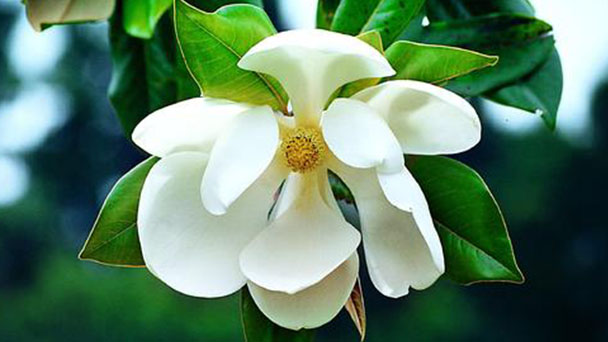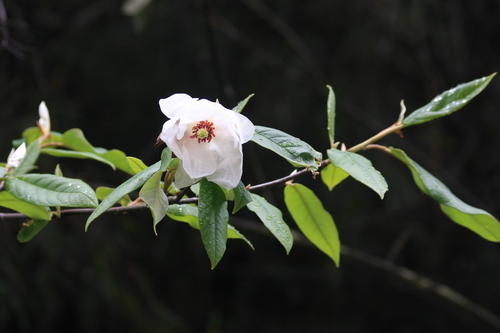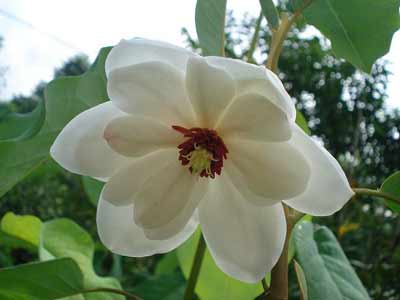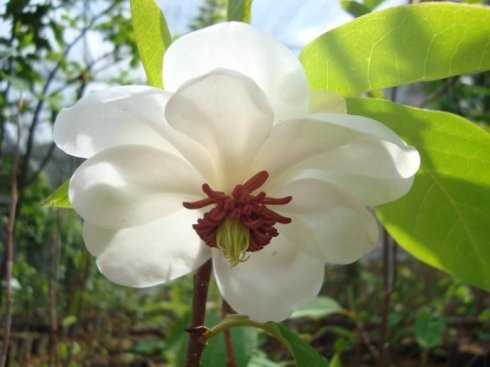Magnolia Wilsonii Profile: Plant Info & Care Guide
Written by Maggie
Dec 07 2021

Magnolia wilsonii is a shrub or tree of the Magnolia family and is a precious ornamental flower. It is produced in the mountainous area of southwest China. Due to deforestation and excessive harvesting, the resources are seriously damaged, the habitat is deteriorated, and the natural regeneration ability is weak. The adult plants are rare and endangered plants under national protection.
Magnolia wilsonii blooms every year in the third month of the lunar calendar. The flowers and leaves are open and drooping at the same time. The milky white flowers are large and beautiful and fragrant.Pistils prominent, stamens dark purple.
Magnolia wilsonii bark is called "turmeric" and is a substitute for Magnolia Magnolia. It is a rare and commonly used traditional Chinese medicine with exact efficacy and reliable therapeutic effect of dryness and dampness, reducing phlegm, relieving asthma, appetizing and dispelling accumulation, and relieving pain. It has an irreplaceable effect on other drugs.
Magnolia Wilsonii Picture

Magnolia Wilsonii Info
| Botanical Name | Magnolia wilsonii |
| Common Names | magnolia |
| Plant Type | Tree |
| Sun | Full Sun, Partial Shade |
| Hardiness Zones | 6 to 9 |
| Flower color | White with rose-purple stamens |
| Native Area | Southern and central China |
| Mature size | 15.00 to 20.00 feet tall, 8.00 to 13.00 feet wide |
Characteristics of Magnolia Wilsonii
Magnolia wilsonii is an evergreen shrub or small tree, bark has obvious lenticels, the current year branches purplish red. Leaves are elliptic ovate or oblong ovate, leaves about 8 cm long, 4 cm wide, shiny; Above along midvein and lateral veins grayish-yellow pilose, below densely silver-gray equinescent pilose. Every year in the spring, flowers and leaves open at the same time, pendulous, milky white flowers, its beautiful flowers, pistil prominent, stamens deep purple, petals in 12, embellish 13 petals, petals for years and natural increase and decrease, very magical, has a very high ornamental value.
Magnolia wilsonii is a precious ornamental flower and tree, which is grown in the coniferous and broad-leaved mixed forest at an altitude of 2700-3500 meters in northwest and west China to Ailao Mountain. It belongs to the national third-class protected plant. After 15 years of efforts by florists in Dali Bai Autonomous Prefecture, Yunnan Province, Magnolia wilsonii, a famous Dali flower lost to the people for hundreds of years, has ended the historical situation that only its name was heard, but no flowers were seen. The first batch of live specimen seedlings of magnolia wilsonii have been successfully bred, and Magnolia wilsonii will reappear in Dali.
Habits of Magnolia Wilsonii
Magnolia wilsonii is a subtropical tree with a light loving nature. But saplings are quite tolerant to shade, like warm and humid climate, have a certain drought tolerance ability, can withstand short-term -19X low temperature and leaves without significant frost injury, but if a long time under -12X low temperature, the leaves are frozen.
Magnolia wilsonii prefers rich, deep, moist, well drained acidic or neutral soils. It grows poorly on dry, calcareous, alkaline soils and poorly drained clays. Magnolia wilsonii is resistant to soot and sulfur dioxide.
Magnolia wilsonii is found in mixed forests at an altitude of 1800 -- 2000 m.
How to Grow and Care for Magnolia Wilsonii
Magnolia Wilsonii Watering
Magnolia wilsonii is a fleshy root. If the soil in the basin is too wet, the leaves will wither and fall off, or even rot to death. If the soil is too dry, the leaves will wither and curl sharply. Flowering period where the petals are too extended, indicating that the water is insufficient, water is suitable is bract; The surface of basin soil is dry, and the soil should be watered immediately when it is hard and dry. Watering requirements of water temperature, soil temperature must be consistent, can not suddenly pour cold water or hot water. Watering must be watered thoroughly, often watering half water will cause shallow roots. Magnolia Wilsonii should not be watered too much in spring and autumn. Water should be watered daily in midsummer and must be watered in the evening. Water should be reduced in late autumn and watered once every 10 days in winter. During the rainy season, move to a shelter.
Soil for Magnolia Wilsonii
Pine needle leaf rot soil 5, coarse bran ash 2, coarse sand 2, retting cooked manure 1 preparation, avoid with poor permeability of fine sand or sticky heavy soil. On the basin with good ventilated earthenware basin (plain burning basin), avoid using glaze basin, porcelain basin, purple sand basin, etc., it is best to use a deeper tubular flower pot, the basin under the cushion buckle empty flower pot, and with brick overhead, in case of poor drainage; Pelvic bottom lays the slag of 5 cm or so, gravel.
Fertilizer for Magnolia Wilsonii
Magnolia wilsonii likes phosphorus and potassium fertilizer, but avoid too high concentration, otherwise it will produce reverse osmosis, causing the plant "physiological drought", light wilting, and heavy is burned to death. Magnolia Wilsonii's fertilizing principle is "sparsely applied, often applied, in the evening applied". Practice has proved that with thin human excrement and urine, bean cake water, mixed with smashed fish, shrimp, chicken offal, retting ripe, according to the ratio of 1:9 fertilizer water, every 3-5 days applied once, application and then mixed with calcium sulfate, the effect is better, can make Magnolia wilsonii fragrance thick.
How to Propagate Magnolia Wilsonii
Magnolia wilsonii is commonly used for grafting propagation, layering propagation, sowing propagation.
Magnolia Wilsonii Propagation from Seed
Magnolia wilsonii sowing propagation can be carried out in autumn after seed harvesting, or it can be deposited in wet sand until sowing in March of the following year, and the seedlings will emerge in May. Seedlings grow slowly, seeding appropriate slightly dense, planting after the second year of transplantation.
Magnolia Wilsonii Propagation by Grafting
In 3~ April, with purple magnolia, mountain magnolia and so on as rootstock, scion flowers, flowers, thick leaves on the mature Magnolia wilsonii of the annual side of the top branch, to leaf, grafting, choking and top, to bud extension after digging to choking, cutting rootstock bud bud bud. Also useful biennial branches to rely on the connection, after 1~2 months can be separated from the mother, independent growth.

Distribution of Magnolia Wilsonii
Magnolia wilsonii is grown in the southwest mountainous area of China.
Magnolia wilsonii is native to the eastern part of North America and is cultivated in the south of the Yangtze River Basin in China. Magnolia wilsonii is found in the northwest and west of China to the ailao mountain, and it is born in the coniferous and broad-leaved mixed forest at an altitude of 2700-3500 meters.
After 15 years of efforts by florists in Dali Bai Autonomous Prefecture, Yunnan Province, Magnolia wilsonii, a famous Dali flower lost to the people for hundreds of years, has ended the historical situation that only its name was heard, but no flowers were seen. The first batch of live specimen seedlings of Magnolia wilsonii have been successfully bred, and Magnolia wilsonii will reappear in Dali.
Magnolia Wilsonii Benefits
Ornamental Value
The petals of Magnolia wilsonii are milky white, with twelve petals in ordinary years and thirteen in leap years. The pistils are like dragon whisker-shaped projections and crystal clear. The deep purple stamen and white petals set off beautiful, sweet flowers, attractive honey taste. Leaf appreciation is "two and a half inches long leaves, half wide, green embellish light", flower appreciation is "Tingting Yan so", "Luxiang Xun Yan", "Rui big and sweet". With the successful breeding of the first batch of Magnolia wilsonii specimen seedlings, following orchids and camellias, another characteristic flower of Dali is bound to ignite a new round of green wealth upgrading.
Medicinal Value
Magnolia wilsonii is a rare and commonly used traditional Chinese medicine with exact efficacy and reliable therapeutic effect of dryness and dampness, reducing phlegm, relieving asthma, appetizing and dispelling accumulation, and relieving pain. It has an irreplaceable effect on other drugs.
Garden Use
Magnolia wilsonii is a majestic tree, evergreen, with a thick shade of green and fragrant flowers. Magnolia Wilsonii can be used in gardens, parks and amusement parks.
It is very suitable for the big tree to be planted alone on the edge of the lawn or on both sides of the passageway. Small and medium-sized people can be planted on the flower bed in a group to become a pure forest small garden. It is coordinated to be planted next to ancient buildings and western buildings.

Latest Updated
- Benefits of Bugleweed - 7 Science-backed Health Benefits
- Bugleweed Dangers & Side Effects - Is It Poisonous?
- How to Plant Evergreen Trees - What You Should Know
- When to Plant Evergreens - Grow Guide for Evergreen Trees
- 12 Wonderful Evergreen Shrubs for Your Garden
- 12 Popular Evergreen Plants with Pictures for Beginners
- When And How To Prune A Lilac Bush Like a Pro
- How to Grow & Care for Lilac Vine (Hardenbergia Violacea)
- Japanese Lilac Tree (Syringa Reticulata) Care & Propagation Guide
- Shumard Oak Pros and Cons - What to Know
Popular Articles
- Winter maintenance of Antirrhinum Majus
- How to Grow Terminalia Mantaly Tree
- How to Grow and Care for Crossostephium Chinense
- How to grow Antirrhinum Majus in spring
- Peristeria Elata (Dove Orchid) Profile: Info & Care Guide
- Underwatered Snake Plant (Sansevieria Trifasciata) - Signs And How To Fix
- How to Care for Brazilian Jasmine Plant (Mandevilla Sanderi)
- How to Grow & Care for Graptopetalum Purple Delight in Summer
- Rosa Chinensis (China Rose): Plant Growing & Care Tips
- How to Care for Baby Sun Rose (Aptenia Cordifolia)